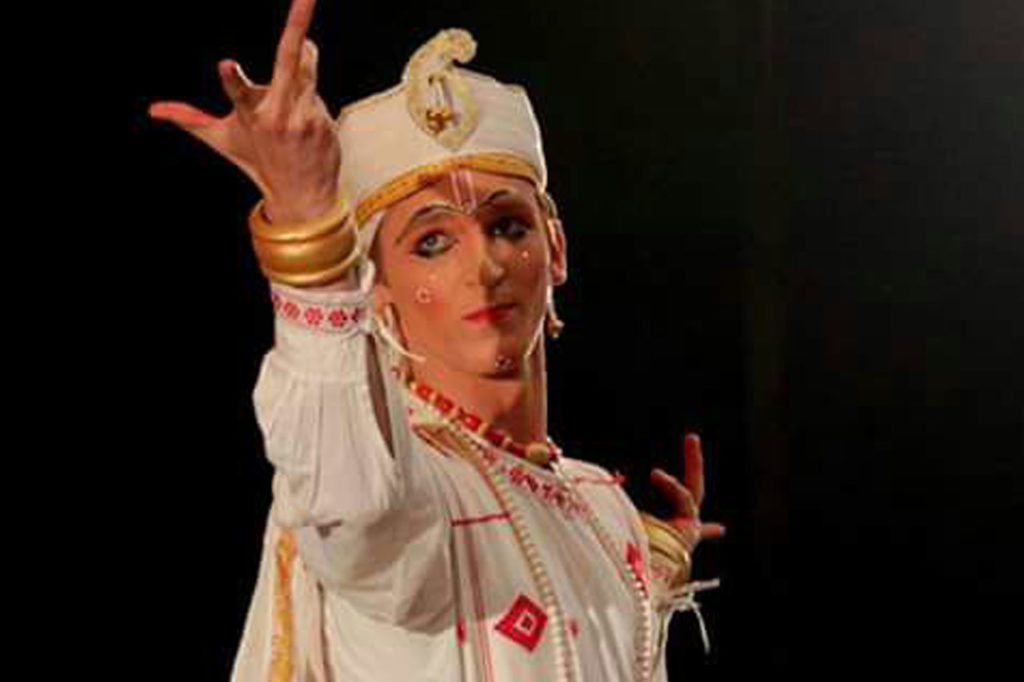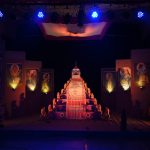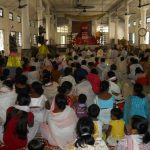Srimanta Sankaradeva (1449-1568), the founder of the Vaishnavite order Eka Sarana Nāma Dharma was a multi-faceted person whose works had different dimensions. In spite of being a religious preceptor, he included aesthetic activities like Sattriyā dance, Bargeet song, Sankari music, Ankiyā plays, painting and sculpture in his scheme of things. Needless to say, all these were his own compositions. Even mundane activities like agricultural production found place in this pattern. Obviously he was a man of the world as well as man for the world. He wanted to make life good and beautiful for people around him. Therein lay his aesthetic approach to life. One who finds beauty in life cares for the quality of other peoples’ lives. Srimanta Sankaradeva did that. He cared for the quality of life for people around him.
Music and dance were essential parts of Srimanta Sankaradeva’s life. He inherited these in his gene. His forefathers had migrated to Assam from Ujjain. They used to be experts of Vedic music. In fact his father Kusumbar Bhuyan was given the epithet Gandharva. The flavour of music reigned supreme in the scheme of Srimanta Sankaradeva’s things. He created twenty five Rāgas himself, in that process giving rise to a new school of classical music, the Sankari school of music. All the prayers in his order were performed in melody, all the plays were full of songs. When his verses were recited by the devotees in community prayers, it was done musically; there were fixed Rāgas for the hymns. Thus all his writings were musical. He continued the ancient Indian tradition of putting all narratives in music. But the more significant aspect was that he himself created the Rāgas to be used while singing his hymns; he did not leave it for others to compose music.
Srimanta Sankaradeva lived so much with music that, he asked the disciples to render songs or poems even when he went on outing with them. Once he engaged three disciples – Madhavadeva, Narayanadas Thakur and Madhai to compose impromptu hymns when they all were on a boat trip. The recital by Madhavadeva overwhelmed Srimanta Sankaradeva and tears flowed along his cheeks. This showed how he relished music and understood its flavour. During his pilgrimages outside Assam also he asked his disciples to sing regularly. Life was full of music for the maestro, who put the lives of people in rhythm. Certainly it was a great aesthetic approach to life. Little wonder, people thronged the institutions set up by him in thousands. Even now there are about a thousand such units in Assam with about fifty thousand devotees residing in them. This would not have happened had the life been dull in them.
What Srimanta Sankaradeva did for people was to fill their lives with meaning. A dull and drab life, engaged in the daily chores of earning livelihood leads to frustration and eventual social discontent. There were already signs of that, as ethnic groups were engaged in conflicts in different parts of Brahmaputra valley. Skirmishes took place frequently among the ethnic groups. There were Koch-Ahom conflict, Kachari-Ahom conflict, Kachari-Bhuyan conflict, Chutiya-Ahom conflict etc. It was then that Srimanta Sankaradeva came out with his innovative life-style, embedded in the socio-religious institution Thān (later known as Sattra) innovated by him. This gave an escape route to people from the mundane inanities. People could transcend their meaningless day to day lives for higher order meaningful lives.
The Thān (Sattra) was a residential institution where the residents had to necessarily engage in cultural activities in addition to religious and agricultural activities. It was different from monasteries. The residents of Thān (Sattra) had to engage in dance, music, drama, painting, sculpture and so on. Manuscriptology was another compulsory activity as the devotees had to learn reading and writing manuscripts. Srimanta Sankaradeva always penned down his compositions and distributed those among the followers so that they could memorise them. All these activities were integrated. When a devotee recited prayer, he did it by singing. When a devotee acted in a play, thereby he worshipped the Lord. When a devotee saw a decorated sculpture in the prayer hall Kirtanghar, he had a pious feeling. Even the farm works were carried out not for a single person, but for the entire community. It gave them pleasure.
The innovations by Srimanta Sankaradeva mentioned above were part and parcel of his scheme of things. His devotees could not do without being engaged in dance, music, plays, painting and sculpture, either in whole or part. Thus all these became integral parts of Eka Sarana Nāma Dharma. Each and every cultural activity necessarily implied a spiritual exercise. The audience felt that. The expression in Sattriyā dance created by the saint gives an idea of prayer unto the almighty. When the danceuse bows down, it is an obeisance to the almighty. Consequently the audience are exported to ecstacy. Even the costumes had implicit philosophical meaning. For example the flowing robe worn by the compere of Ankiyā play, the Suttradhāra signifies that God is beyond sex.
The paraphernalia in the enactment of these Ankiyā plays carried deep significance. For example, the entry-path for the actors called Agnigarh having nine wicks overhead signifies the nine modes of devotion. The objects kept in the Kirtanghar are also highly symbolic, with implicit meaning, to be deciphered by the devotees. The seven-layer altar Guru-āsana itself has great significance, embodying deep philosophical theories. The devotee has to understand those meaning. This exploration gives the devotees great satisfaction. For example, even the seating mat named Kath was also used by Srimanta Sankaradeva to convey spiritual message. These imparting of knowledge were done in phases, so that the concerned devotee could get matured gradually in order to digest the philosophy embedded in it. Getting knowledge has its own pleasure, provided it is at the right time.
The pleasure derived from the cultural ingredients was certainly an impetus for the devotees to grow spiritually. It is elevation of the soul with song, music, dance etc. More the audience goes into the content of an Ankiyā play, the more seeped in they become in the philosophy of Srimanta Sankaradeva. If one listens to a Bargeet, one realises the truth of life. It is a way of having self-realisation with flavour. Rigour of Yoga or self-control of an ascetic is not needed in Srimanta Sankaradeva’s order. There cannot be a better aesthetic way in any religion. The Koch royal prince, Chilarai got attracted to Srimanta Sankaradeva after listening to Bargeet songs composed by the saint. This happened with a merchant named Bhabananda also. When the saint met Koch king Naranarayana for the first time, he recited a Sanskrit hymn eulogising lord Vishnu; the learned king, who was educated in Varanashi and well-versed in Sanskrit was totally won over by this and he asked the saint to sit on the pedestal of the throne itself.
How important aesthatics was for Srimanta Sankaradeva can be understood from the fact that he sang a Bargeet even moments before taking his last breath. When the news of his eldest son Ramananda’s birth was delivered to him, even then he broke into a Bargeet to express his anguish that he had got more and more into the mundane illusions. When the news of Srimanta Sankaradeva’s passing away reached his spiritual successor Madhavadeva, the latter too broke into an impromptu Bargeet song. Really, those were incredibly beautiful people. They were always seeped in ecstacy all the time. Emotion came naturally to them. They were not indifferent evangelists. They were engaged in transcending people from stressful situations to situation full of artistic flavours. They brought out the beauty lying dormant in people. When Srimanta Sankaradeva said that the same universal self inhabited the dog, ass, jackal as well as human beings, he emphasised that very approach of love for all. Only people with aesthetic approach to life could do that. Without aesthetics, there could not be Eka Sarana Nāma Dharma. Aesthetics was an integral part of this order and it continues to be so, even after half a millennium.
The aesthetic experiences in the order led to some unusual events too. Once the devotees were performing community prayer in the Kirtanghar. One elderly devotee named Daivagnya passed urine inadvertently as he was totally immersed in the flavour of the prayer. It led to some discomfiture among the devotees when they realised what had happened. But Srimanta Sankaradeva quietly got up from his seat, took Daivagnya away for bath and washed the floor himself. Evidently the saint was in an ecstatic state all these while alongwith Daivagnya and many others. That such an atmosphere permeated the Eka Sarana Nāma Dharma community was an uncommon thing.
People of other religions also got the quiet, peaceful flavour of Eka Sarana Nāma Dharma through the cultural ingredients, which carried the message of Srimanta Sankaradeva. When a follower of Islam witnesses dance, music, plays of Srimanta Sankaradeva, he may feel a homage to Allah. This in fact happened. Ajan Phakir alias Shah Miran, the 17th century Islamic Peer, who hailed from Iraq and settled in Assam, was impressed by the hymns of Srimanta Sankaradeva very much; he alluded to the saint several times in his own compositions, known as Jikir. This respect for Eka Sarana Nāma Dharma among the Muslim people is really noteworthy. Even now several old Sattras are being taken care of by the Muslim people living in the vicinity.
Apart from the cultural ingredients, the explicit nature of the earth was also important in the Eka Sarana Nāma Dharma order. Srimanta Sankaradeva did not ignore the nature, the common source of aesthetic experience for the lay people. His writings are replete with beautiful descriptions of the nature, especially during the autumn season. How the flowers were in full bloom and the entire nature was glowing was presented in his verses in unmatched manner. He described hundreds of species of flora available in the Brahmaputra valley in his verses. Only someone who has deep love for the nature can do that. Several chapters of his magnum-opus Kirtana-ghoshā has such narrations. Gajendra-upākhyāna, Rāsa-krirā, Haramohana are such chapters. It is evident that the poet saint derived immense pleasure in being with nature. In fact he said in one verse that one tree was equivalent to ten sons.
In this context, the Rāsa of lord Krishna in Vrindavana described by the saint in the chapter Rāsa-krirā of Kirtana-ghoshā is a marvellous piece of writing. Since Rāsa is all about union between individual self with the universal self, it is the ultimate bliss. Rāsa gives the ultimate Rasa to the devotee. It is the ultimate aesthatic experience one can have. But Srimanta Sankaradeva carefully restrained it in order to prevent the inroads made by the decadent Sahajiyā cult in the medieval times. He repeatedly warned that Rāsa was a sport of God and a way to overcome carnal desires. This is all the more important as there is no female deity worship in his Vaishnavite order, a speciality among all Vaishnavite orders. He was careful to project Rāsa as an allegory, not something to be emulated in gross manner. It is this restrained approach towards life that has made it possible for the order to survive till now, without any degeneration.
Srimanta Sankaradeva took the ingredients of his writings from Sanskrit scriptures, but changed them to his own style. He was not a translator, but a trascreator. The salient features of his writings like Kirtana-ghoshā is the choice of language. The secret of how he touched chord with the audience lay in this fact. He used less of Sanskrit-origin words and more of ethnic-origin words in his writings. It was more pronounced in his choice of words in case of compositions like Bargeet and Ankiyā plays. He used the lingua franca of people, the dialects used by the commoners. He used idioms and phrases used by the common people. He incorporated names of local flora and fauna in the narratives. Not only that, he even abridged those portions which were not in tune with the devotional philosophy preached by him. Narratives of battle etc were shortened and sermons about devotion to lord Krishna elaborated. He reduced the part elucidating the path of knowledge while transcreating the third canto of Bhāgavata, as his thrust was on devotion. He also deviated from the original Uttarākānda Rāmāyana and projected Sita as a very courageous woman who could criticise her husband for his shortcomings. The readers get a Rasa (flavour) of emancipation instead of submission in his writings.
Srimanta Sankaradeva’s mode of conveying different flavours was through the use of simile, metaphor etc. In the play Rukmini Harana, he compares the face of lord Rama with the glowing moon, while the nose of Sita is likened to a beautiful flower. He also embellished his writings with Alankāra like Atishayokti, Punaruktabadābhāsha, Upamā, Rupaka, Antyānuprāsa, Prateeka, Anuprāsa etc.
Though Srimanta Sankaradeva was a great scholar of Sanskrit language and author of a famous Sanskrit treatise Bhakti-Ratnākara, his majority works were in the language of the masses, popularly known as Brajāwali. The dialect prevailing in Western part of Assam dominated this form; as such it had affinity to the dialects in Bengal, Mithila etc, which all emanated from the same Māgadhi Prākrita. Little wonder, the Ankiyā plays of Srimanta Sankaradeva became extremely popular in those parts. People in Bengal started emulating his Ankiyā play Kāliya-Damana, so much so that a phase of Bengal’s history, 16th to 19th century, came to be known as Kāliya-Damana Yatra era. It was in this process that the Yātrā movement was born in that region. Not only the language, the flavour of the Ankiyā plays also contributed to this popularity. While all nine Rasa (flavours) were present in these plays, Shānta-Rasa was predominant in them; it relegated other flavours to the background. So whenever an Ankiyā play is enacted, a calmness descends on the arena. It becomes evident when Krishna vanquishes Indra in Pārijāta Harana and Indra prays to Krishna; it is also seen when Krishna vanquishes the serpent Kali and the serpent prays to Krishna in Kāliya Damana. In fact, the entire act of play is performed as worship of the almighty and an altar is necessarily kept there.
The aesthatics of Srimanta Sankaradeva came out explicitly in the costumes used in his plays as well as dances. He was a great textile designer. He used to design the clothes produced by the weavers in his land. He was a Bhuyan scion and the Bhuyans had traditional expertise in textile weaving. Textile items used to be exported from his kingdom; it may be noted that Srimanta Sankaradeva’s family ruled a large part of the middle Assam. The textile aesthatics came out in the most prominent manner in his magnum opus Vrindāvani cloth, that depicted the life of lord Krishna in cloth. The maestro prepared it at the request of king Naranarayana in the later part of his life. It is now preserved in the Musee Guimet, Paris. The pictures woven therein exuded the colours of life as well as elements of motion. Similarly the costumes of the Ankiyā plays exuded spiritual calmness. Make-up of every character varied and generated affection or devotional feeling in the audience, depending on the character. Feelings of love, desperation, anger, fear, surprise etc also were successfully generated by these costumes and make-up.




